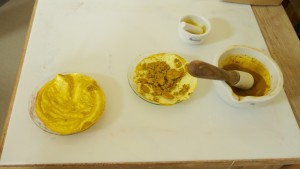What we Teach
Our approach to painting is through the technique of watercolour. We favour plant-based pigments, which have a particular light quality and vivifying action on the soul.
The training is based on indications for a new art of painting given by Dr.Rudolf Steiner (1861-1925) in his lectures, paintings and sketches. Known collectively as the Training Sketches these ‘picture seeds’ were done in answer to a request from the painter Henni Geck as a way forward for her painting school. Henni Geck (1884-1951) was the first painter to use these indications.
In 1928 Gerard Wagner (1906-1999) became Henni Geck’s pupil and throughout the following years based his painting and colour research on the Training Sketches. Through these he was able to find a key to answering the question of how form comes out of colour. He wrote:
Rudolf Steiner formulated the question that is the decisive one for painters today: how does form arise out of colour? In his sketches and paintings Rudolf Steiner gave examples of how colour can lead to form, as well as to an experience of the world of formative forces. For this reason the Training Sketches can be regarded as the beginning of a new art of painting, which is in accordance with the development of modern consciousness.
Curriculum
The curriculum is intended to develop insight into the interrelation of colour and form; the aim is to reach an individual living experience of how form comes out of colour.
Short blocks of colour eurythmy and black and white shaded drawing accompany the painting activity.
The contents of the study sessions are mostly Rudolf Steiner’s lectures on art, colour and art history. These ‘study sessions” consist of reading, conversation, and student or teacher presentations.
The painting curriculum includes:
- The colour theories of Johann Wolfgang von Goethe (1749-1832)
and Dr. Rudolf Steiner (1861-1925). - Colour balance as principle of unity and harmony: warm and cool colours;
image and lustre colours; light and dark. - Composition: ‘measuring’ the colours into the picture-space;
the inner balance of the human being as ‘measuring’ instrument. - Enhancing a capacity for experiencing colour: measure, number and weight as qualitative experience; weightless colour.
- Colour processes – Nature processes: rhythms; the cycle of the year;
growing and fading; rising and setting. - Motif transformation leading to metamorphosis.
- Self- development: painting as a path of meditation.
- Painting therapy: inner balance and health.
- Plant colours: production of plant-based pigments and their use.
Study Opportunities:

 English
English
